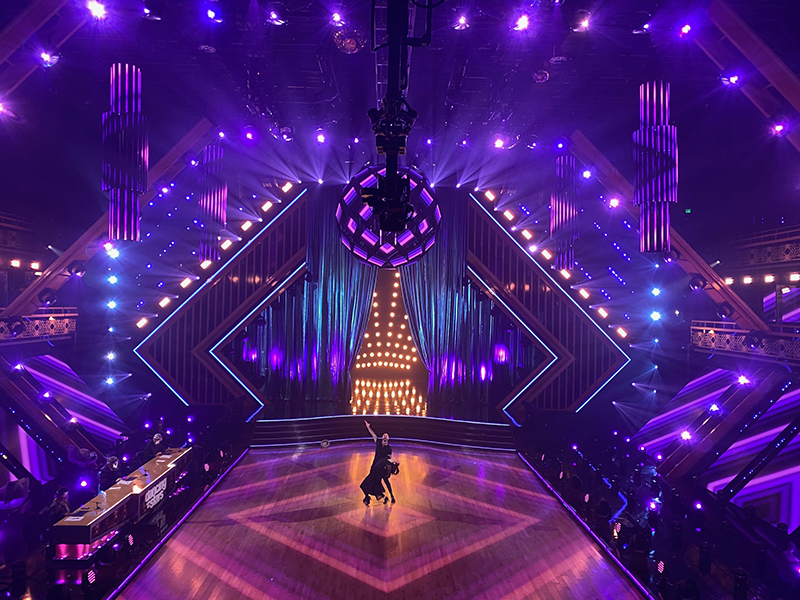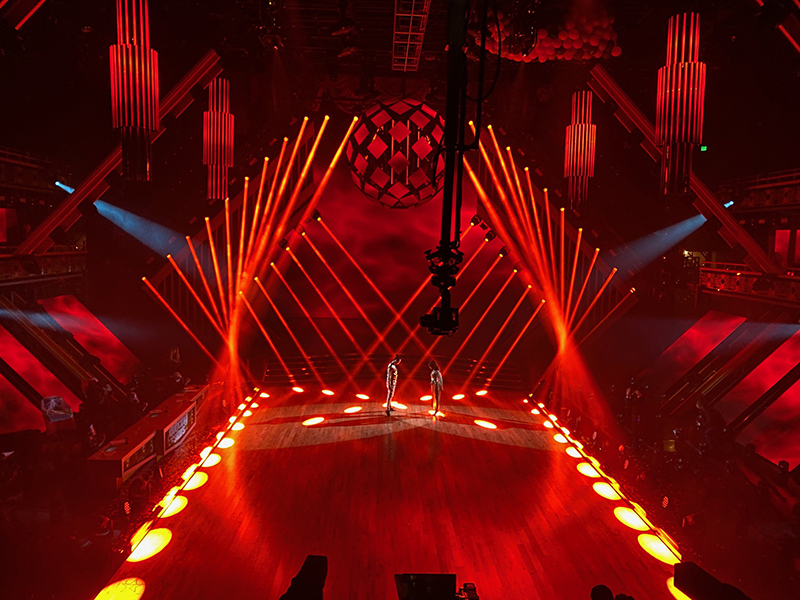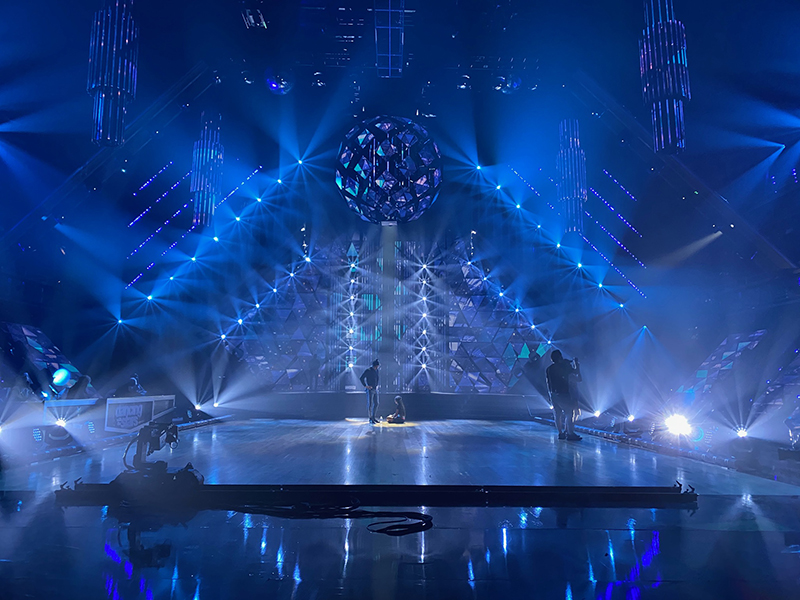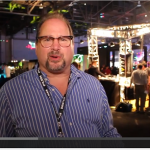
Living the Dream and Forging New Visions
Internationally known and multi award winning lighting designer Tom Sutherland is, at age 32, able to look on a career that has spanned 20 years thus far. Very early on, the London native knew the answer to that eternal question, “What am I going to do with my life?” He has handled the trajectory that followed at breakneck speed with humor, humility and a self-assuredness that made him, at age 22, the youngest designer to be nominated for a Knight of Illumination Award.
Stepping away for a moment from rehearsals on his latest television project, a show called Alter Ego, Sutherland spoke with PLSN. “It involves an actor backstage in a motion capture suit who has created an avatar projected onto a stage before a studio audience and judging panel,” he explains. “It’s a strange one because the audience in the studio can’t see what is actually happening on stage since the avatar is in augmented reality.”
At age 12, Sutherland augmented his own reality by writing letters introducing himself to leading designers in London’s West End and major television networks. At school, he was involved with the drama department, and on weekends, his parents took him to theatrical productions in the West End. “I was in awe of the technology and the emotion that could be produced by a light,” he recalls.

The electrics department on a performance of The Lion King took him under their wing, “which is where I started my technical education.” BBC lighting designer Mark Kenyon responded by inviting the aspiring lad to visit him and his team on some of his shows. Four years later, Sutherland was programming his first national TV show — on his 16th birthday.
From age 18-23, “I worked a lot in night clubs,” he says. Sutherland continued picking up bits of work as a programmer on shows produced by Simon Cowell such as X-Factor and Britain’s Got Talent. Amidst all this fervent activity, BBC Radio One called on him to light a production of a Red Hot Chili Peppers concert. “It was my first proper lighting design,” recalls Sutherland — and the one that would garner the aforementioned Knight of Illumination nomination.
When the X Factor lighting designer was invited to the USA to start up America’s Got Talent, Sutherland, who by now had caught Cowell’s attention, was promoted to light all the audition stages. It was about this time (2012) that Sutherland formally created DX7 Design — with one employee, himself.
Despite his keen interest in a career in lighting, “there was no real plan in place,” as to where or how that would take shape. “I have been very lucky that I have not had to go around and knock on many doors. One thing has fallen into my lap and led to another thing. I think the secret to that is just being honest with yourself. Knowing how much you can take on the things that interest you. The main thing is, don’t take on things that your heart is not going to be into.”
This inherent yearning has worked well for him in balancing his television studio work with his myriad touring and concert projects. The live concert rock ‘n’ roll setting has embellished his work on American Idol in particular.
In 2015 Cowell, along with Ricky Martin, produced a show called La Banda for Univision in Miami and handed the lighting design reins
to Sutherland “His team rang me up and said, ‘Come to the U.S.,’ and I told them, ‘Oh I have to think about that.’ Of course, once the connection was ended, I was jumping up and down, shouting in joy!” The original shoot of five months turned into a two-year stay, during which time he established a DX7 office in America.
“I didn’t really know many people or have a team in place when I came to America in 2015. It was very vital that I figure out how to have the right people around me, because things were starting to explode, particularly when I was invited to China in 2015 also. The people I have around me are the reason for the success I have had over the last few years.”

The DX7 Team
Again, luck or providence played in the evolution of Sutherland’s career. Out of the blue, a programmer totally unknown to Sutherland at the time, arrived seeking work. “Joe Holdman is a great friend now and a fundamental key within the company as my business partner. We’re in the trenches together on practically every project. Between us, we come up with some wacky ideas. We very much love and endure each other’s company. It’s great to have someone that close working with me. I don’t even need to say anything, he’s already done it.
“As things got progressively crazy, I realized we were going to need to bring on more people, which was a bit nerve-wracking; the idea of taking on and being responsible for employees,” Sutherland continues. Hunter Selby, another unknown to Tom at the time, reached out to Sutherland and asked to come look at a few shows. The timing couldn’t have been more serendipitous. “I had a show in China at the time. I wrote him back and asked if he would like to be thrown in the deep end, and he said ‘Okay.’ I offered him a job shortly after that show. Hunter assists me in all renderings and plans. In the past few months, an awesome lady, Jasmine Lesane, joined us. Jasmine assists with the workload and everything that comes our way. We also have Luke Chantrell who is our shader — our video controller.
“I find that the person who shades and grades cameras is a very vital piece in television productions,” Sutherland notes. “Nobody would post a picture or Instagram without filters. Luke does that with 20 cameras, live. I see that role very much like the lighting programmer role. I try to push effects and push the creative as much as I can; Luke can then balance the side effects through the camera.”

The Design Process
A mantra Sutherland often repeats is, “Video sets the scene, and lighting the emotion.” He is also a big adherent to negative space in content. “It takes the illusion away when big solid massive content fills the screen. You want to allow the audience to enter the world of wherever the artist wants to take you. Whether designing for a television show or a pop artist, I approach it by finding what that client needs in particular to make their show look great. The very first thing I ask them is to tell me, ‘What from your heart do you want to bring to the stage?’ My job is to tell that story.”
Sutherland tries to build lighting into the sets as much as possible, “so it looks like one whole piece and not just lots of random truss plopped on top of the set.” That process often starts with the scenic designer to ensure that “scenic and lighting design merge perfectly into one whole product.” As an example, Sutherland points to Dancing With the Stars, which features huge metal girders shaping the room above the dance floor, creating the look of a real kind of club. These were specifically built to house a type of lighting unit. “Everything has to have structure. I accent the geography and the design with light, making sure we place certain beams in certain places so we can change the architecture or change the shape.”
The importance and interplay of structure in his lighting design took on particular prominence during last year’s season of DWTS, which had to shoot without an audience due to the Covid-19 concerns. “We had to come up with a clever way to create the atmosphere of excitement that gets delivered through a live audience; choosing to make the show about the dancers and not do any gimmicks. We did that through gorgeous architecture, through the beautiful lighting and video. To translate the emotion across the screen, we added more layers of lighting to fill the voids. We really took that space and transformed it with the clicks of some very creative people’s fingers. The producers tell me it was one of their favorite years, and I’m thrilled to receive my first Emmy Nomination for the 2020 design.”
So what sets his designs apart? “I’d love to think, that we are pushing the boundaries of television,” Sutherland says. “We’re not afraid to turn lights off or shade people in different colors and textures. We also do things that are not from the common television textbook.”
Asked to comment on some of the favorite lighting fixtures, Sutherland puts a high priority on brightness and versatility. “As a fan of beams, I think Robe has developed a brilliant product in the MegaPointes. I pretty much use it across the board because it has so much in it. With 11 or 12 episodes a season and 150 odd performances, I need a light that can give me multi options so I can mix and match to create these individual unique performances. For a key light, the Martin Encore LED is my go-to; it’s a great nice even light source. They are engineered so well that rarely does the color temperature drift as the light gets older. They all line up incredibly well.”

Meanwhile in China
The China market for Sutherland practically exploded overnight; so much so that, in 2016, DX7 established a satellite office in Shanghai. It started inauspiciously enough when Sutherland helped out friend and mentor LD Roger Williams. The Chinese had bought an entertainment format from the BBC and were looking for someone from the lighting team to act as a consultant. Williams had commitments and couldn’t go, so Sutherland embarked on his first trip to the country.
While there, his translator told him that another TV studio wanted him to put on a presentation for them. Figuring on a low-key business meeting with maybe eight people from the lighting department, he agreed and put together a brief. Upon arriving, “I saw probably the biggest screen I had ever seen in my life at the time,” with his name emblazoned in big bold letters and a studio filled with some 500 people seated. “Here I am, at 20 years, and I freaked momentarily.”
Following this dive into the deep end, set designer Florian Wieder reached out and broadened Sutherland’s access by recommending him to Hunan TV, the NBC of China. The two have worked on both DWTS and American Idol. Soon, he was working on some of their bigger projects, “which are always a bit tricky,” notes Sutherland. “But they have the technology and resources allowing for some special projects not necessarily doable in other parts of the world.”
Through what has been a meteoric rise, Sutherland has maintained a sense of humility about it all. His favorite piece of advice he has received is, “‘Know what you don’t know.’ I’m still learning and still asking the experts. Success in this line of work, I have found, takes a lot of hard work and determination. Learning and growing from that is what I have always enjoyed about my career. I would advise anyone just starting out to not be afraid of your mistakes. Knowing when you are wrong is part of being a good designer.”
* All images are from Dancing With The Stars’ 2020 season, for which Tom Sutherland is nominated for an Emmy Award. (The ceremony takes place Sept. 19 at the Event Deck at LA Live in Los Angeles.) For more info on Tom and his company, go to www.dx7design.com.


